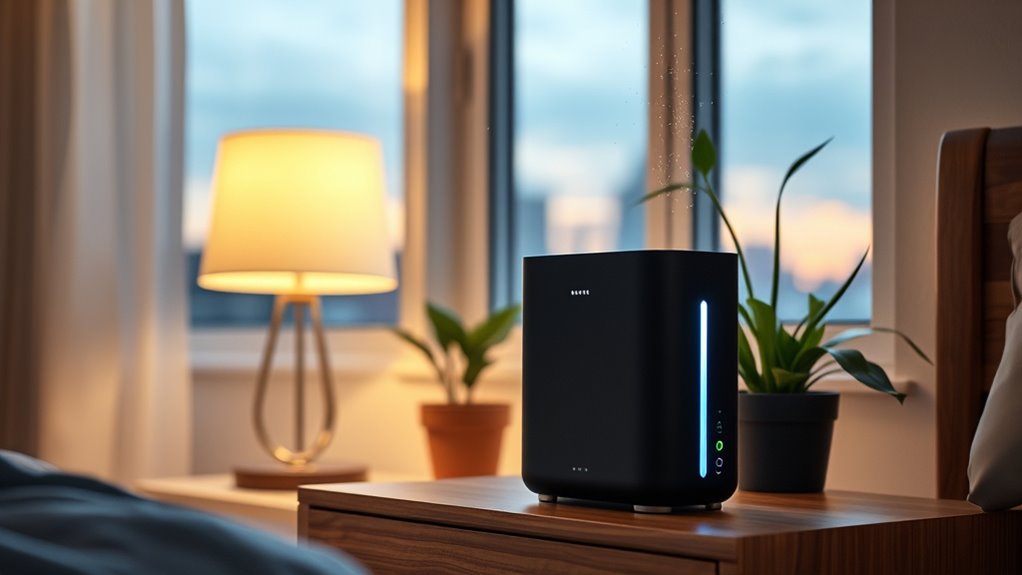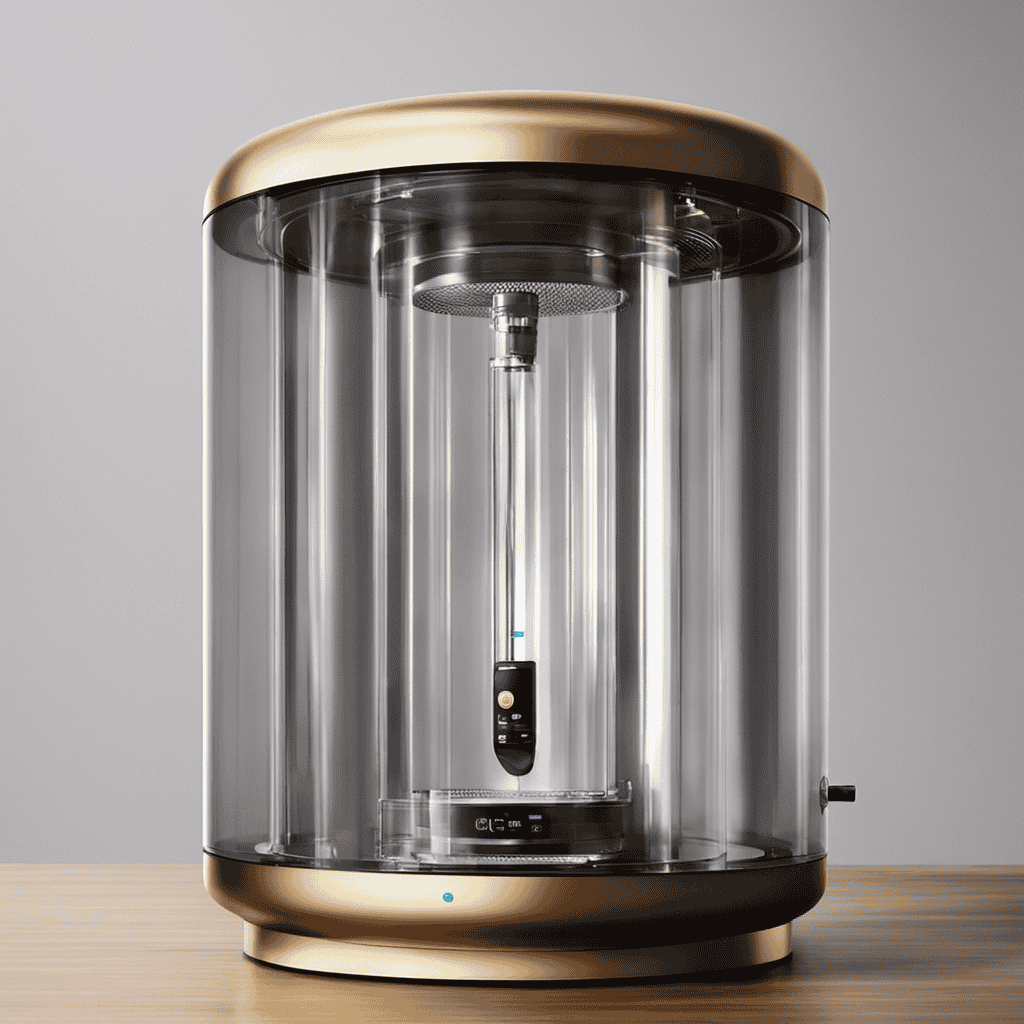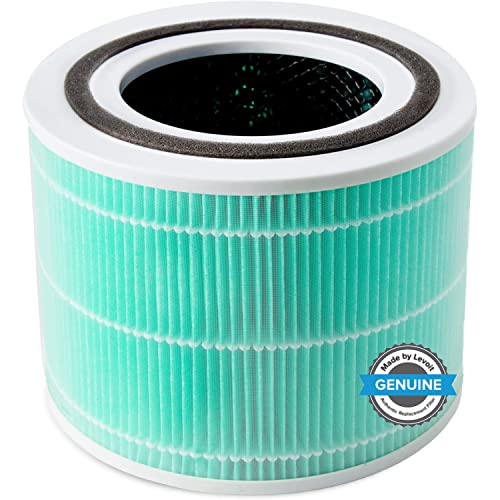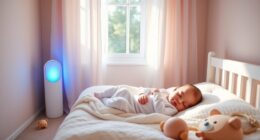An air purifier can make you sick if it’s poorly maintained, uses low-quality filters, or emits harmful substances like excess ozone. Damaged filters can release allergens or bacteria, and cheap materials might shed particles or VOCs into your home. Improper placement or neglecting filter changes can lead to health issues like headaches or allergies. To stay safe, there are simple steps you can follow—discover how proper use makes all the difference.
Key Takeaways
- Damaged or poorly maintained filters can release trapped allergens or bacteria, potentially causing health issues.
- Using low-quality or incompatible filters may shed particles or chemicals into the air.
- Ozone-emitting devices exceeding safety standards can irritate lungs and worsen respiratory conditions.
- Improper placement or malfunctioning units can circulate unfiltered air, leading to health problems.
- Neglecting regular filter replacement and maintenance can result in mold or bacterial growth inside the purifier.
How Air Purifiers Work to Improve Indoor Air Quality
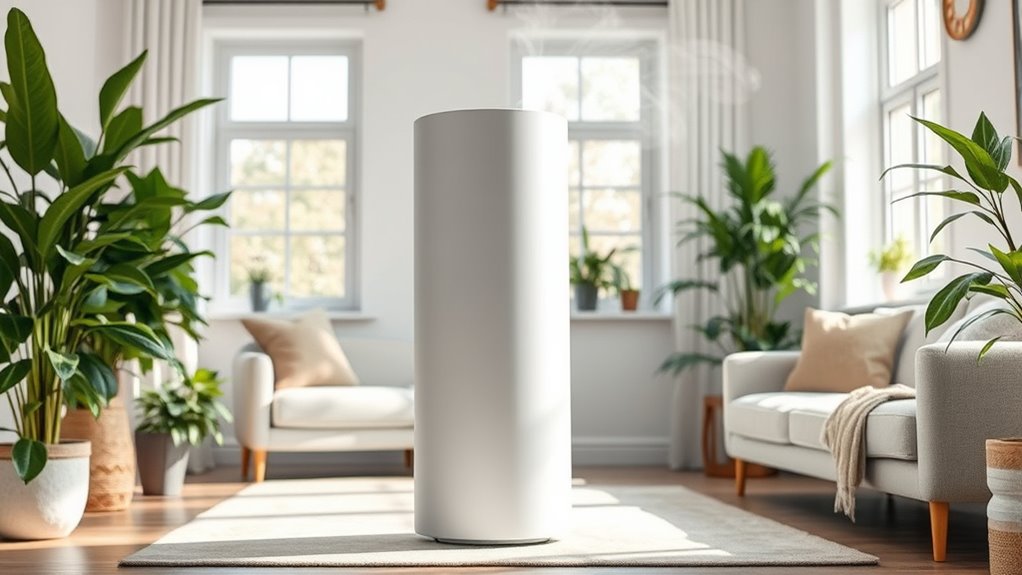
Air purifiers work by actively filtering out pollutants and allergens from the air you breathe. The core of this process is air purifier technology, which typically uses HEPA filters, activated carbon, or UV light to target different contaminants. HEPA filters trap tiny particles like dust, pollen, pet dander, and some bacteria, profoundly improving indoor air quality. Activated carbon absorbs odors, smoke, and chemical fumes, further purifying the air. UV light can kill bacteria and viruses, adding an extra layer of protection. When you turn on an air purifier, it draws in air, filters out harmful particles and gases, then releases cleaner air back into your space. This continuous process helps create a healthier environment by reducing airborne pollutants that can trigger allergies or respiratory issues. Additionally, air purifier technology continues to evolve, incorporating features like smart sensors and automatic adjustments to optimize air quality. Some advanced models also include real-time air quality monitoring, allowing users to track improvements and maintain optimal conditions. Proper maintenance, such as regular filter replacements, is essential to ensure the device functions effectively and doesn’t become a source of contaminant buildup.
Common Types of Air Purifiers and Their Potential Risks

Some air purifiers with HEPA filters can release harmful particles if they’re damaged or improperly maintained. You also need to watch out for units that emit ozone, which can irritate your lungs and worsen respiratory issues. Understanding these risks helps you choose safer options for cleaner indoor air. Additionally, selecting a HEPA filtration system with proper certification can ensure that your air quality remains unaffected by electronic devices. Regular maintenance and choosing certified models can further reduce potential health risks associated with air purification. Moreover, advances in AI technology are being integrated into smart air purifiers to monitor air quality in real-time and optimize filtration, further enhancing safety and effectiveness.
HEPA Filter Hazards
While HEPA filters are widely praised for their ability to trap tiny particles, they can also pose health risks if not maintained properly. When not cleaned or replaced regularly, mold, bacteria, and trapped airborne allergens can build up inside the filter, releasing allergens back into your air. This can worsen allergies or cause respiratory issues. Poor maintenance might also lead to the growth of mold within the filter, which then becomes airborne. To help you stay safe, consider these factors:
| Factor | Risk | Solution |
|---|---|---|
| Dirty HEPA filter | Releasing airborne allergens and bacteria | Regular cleaning or replacement |
| Improper installation | Filter not sealing properly, letting unfiltered air in | Proper setup and check-ups |
| Low-quality filters | Reduced efficacy, increased risk of allergens release | Use certified HEPA filters |
| Overused filters | Bacterial growth, mold development | Replace on schedule |
Ozone Emission Concerns
Have you ever wondered if the air purifier you’re using might be doing more harm than good? Ozone emission concerns are a real issue, especially with certain types like ozone generators. While these devices claim to clean the air, they produce ozone, which can irritate your lungs and worsen respiratory problems. Ozone safety is a top priority, and emission regulations now limit how much ozone such devices can emit. However, not all purifiers follow these guidelines, so it’s imperative to check product labels and certifications. Using an air purifier that exceeds ozone emission regulations can expose you to health risks, particularly if you have asthma or allergies. Always choose models that comply with safety standards to ensure your air is truly cleaner without compromising your health. Regularly monitor your air quality to ensure your purifier is functioning safely and effectively. Understanding air purification technologies can help you make informed choices about the devices you use in your home. Additionally, being aware of the regulatory standards for ozone emissions can help you select safer air purification options. Incorporating proper maintenance routines can also help minimize potential ozone exposure and ensure your device operates as intended, thereby reducing health risks associated with improper use.
Materials and Filters That Could Cause Health Concerns

Materials and filters in air purifiers can sometimes pose health risks if they release harmful particles or chemicals into the air. The manufacturing materials used in the device, such as plastics or adhesives, may emit volatile organic compounds (VOCs) or other pollutants over time. Additionally, the filter chemical composition is vital; some filters contain activated carbon, fiberglass, or synthetic fibers that can shed particles if damaged or deteriorated. Poor-quality filters might release fine particles or chemicals that irritate your respiratory system or exacerbate allergies. It’s imperative to choose air purifiers with filters made from safe, non-toxic materials and to verify the manufacturing standards. Selecting devices with regulated manufacturing standards can ensure better safety and reduce the risk of harmful emissions. Furthermore, opting for models with certified filter materials can help ensure the filters meet safety and environmental standards, reducing potential health concerns. Being aware of the material composition of filters can also help prevent exposure to potentially hazardous substances. Ensuring that the filter replacement process is straightforward and safe can further minimize accidental exposure to harmful particles during maintenance.
Proper Use and Maintenance to Prevent Health Issues
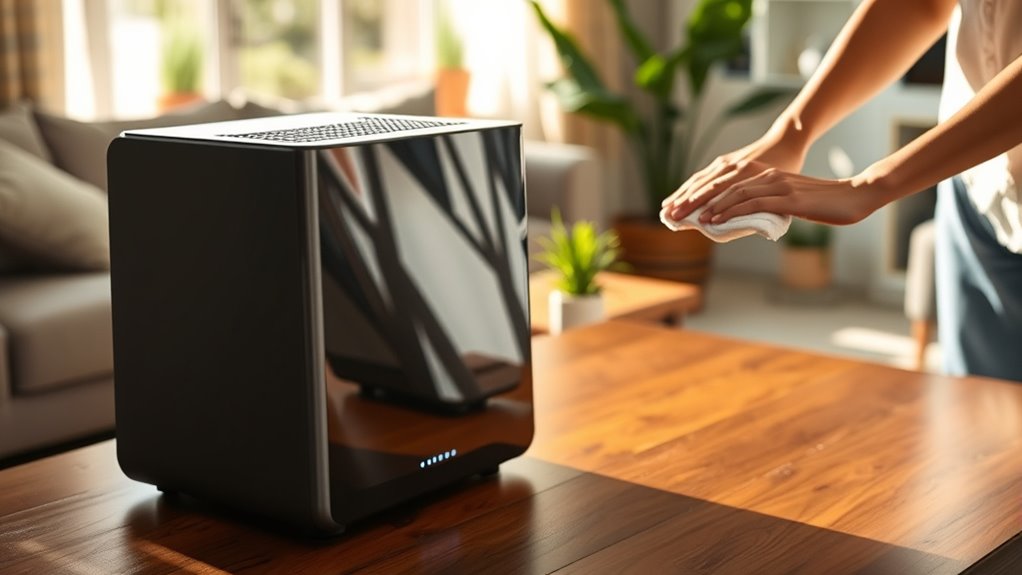
To keep your air purifier working safely, you need to replace the filters regularly. Proper placement also matters—avoid putting it where it can stir up dust or block airflow. Staying on top of these tasks helps prevent health issues and guarantees cleaner air. Additionally, ensuring proper ventilation can enhance air quality and reduce the buildup of indoor pollutants. Using an airless paint sprayer correctly and maintaining it properly can prevent the release of harmful fumes and particles into your environment.
Regular Filter Replacement
Regularly replacing the filter in your air purifier is crucial to guarantee it functions effectively and doesn’t become a source of health issues. Over time, the filter’s lifespan decreases, and allergen buildup can clog it, reducing its ability to trap pollutants. If you neglect to change the filter, dust, pollen, and other allergens may circulate back into your indoor air. This can worsen allergy symptoms or even cause new respiratory problems. Check your manufacturer’s recommendations for how often to replace the filter, typically every 3 to 6 months. Regular replacement ensures your air purifier continues to operate efficiently, maintains good air quality, and prevents the filter from becoming a health hazard. Staying on top of filter maintenance is a simple but essential step to keep your indoor air safe. Incorporating proper maintenance into your routine can significantly reduce the risk of indoor air pollution impacting your health. Additionally, understanding the role of filters in trapping airborne contaminants highlights the importance of timely replacements to sustain air quality. Neglecting these replacements can lead to decreased filter effectiveness, allowing pollutants to bypass filtration and circulate freely. Moreover, utilizing AI-powered diagnostics can help monitor your air purifier’s performance and advise on optimal replacement schedules. Regularly checking for filter clogging or damage can also prevent airflow issues and ensure the device functions optimally.
Proper Placement Strategies
Proper placement of your air purifier is essential to guarantee it works effectively and doesn’t circulate pollutants that could harm your health. Start with placement tips like placing the unit in the center of the room or near sources of indoor pollution, such as smokers or pets. Avoid blocking air intake or outlet vents with furniture or curtains, which hampers airflow. For room optimization, keep the purifier at least a few feet away from walls and avoid corners, ensuring even air circulation. Position it on a flat surface to prevent vibrations and noise. Regularly check and adjust the placement as needed to maximize efficiency. Properly positioning your air purifier enhances its ability to filter pollutants, making your space healthier and reducing the risk of health issues caused by improper placement. Additionally, consider airflow and circulation patterns to further optimize the purifier’s effectiveness. Ensuring correct placement also helps prevent the device from overworking, which can lead to malfunctions and reduced lifespan. When selecting a spot, also keep in mind the importance of filter maintenance to maintain optimal performance. Incorporating innovative materials used in modern air purifiers can further improve filtration efficiency and longevity. Moreover, understanding how technology integration enhances overall air quality can help you make smarter choices in device placement and use.
Symptoms and Signs of Air Purifier-Related Health Problems
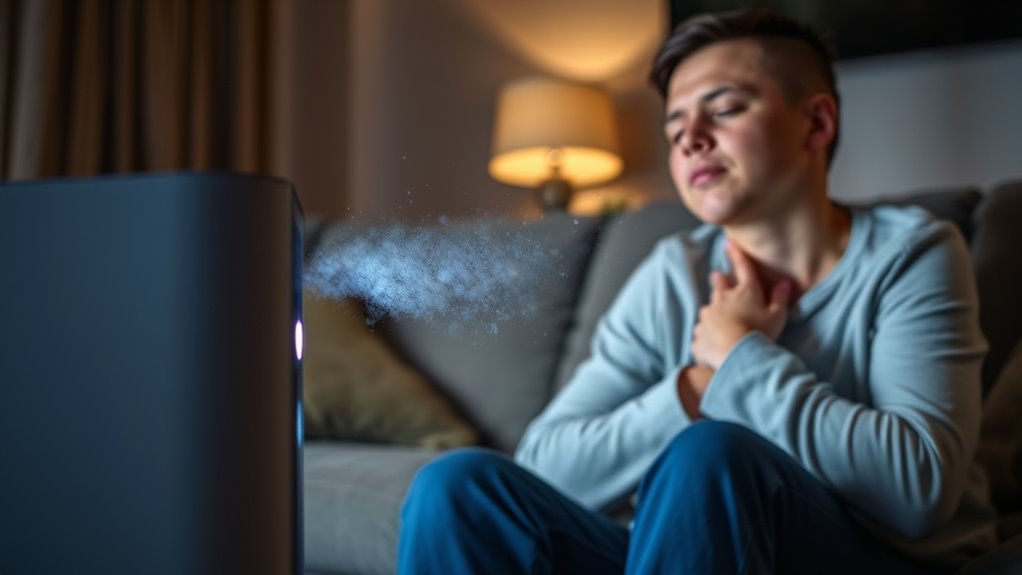
You might start noticing symptoms such as headaches, dizziness, or throat irritation after prolonged exposure to an air purifier that’s malfunctioning or emitting harmful substances. These health signs can be subtle at first but may worsen over time. You could also experience coughing, sneezing, or worsening allergy symptoms. Sometimes, indoor plants or humidifier effects in your home can mask or exacerbate these issues, making it harder to identify the root cause. Watch out for feelings of fatigue, chest tightness, or skin irritation, which could signal a reaction to airborne pollutants. These symptoms are warning signs that your air purifier might be releasing harmful particles or chemicals, jeopardizing your health and creating an uncomfortable environment. Additionally, improper maintenance or use of the device can lead to trust issues with the equipment, further compromising indoor air quality. Stay alert and monitor your symptoms carefully.
Choosing Safe and Effective Air Purifiers for Your Home
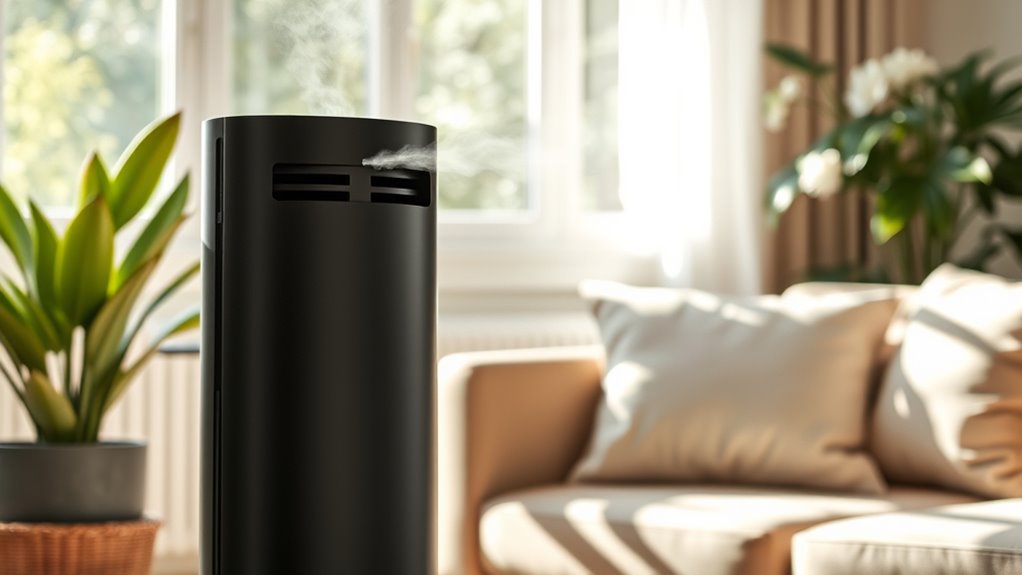
Choosing the right air purifier can considerably reduce the risk of health problems caused by malfunctioning or harmful devices. Look for models with smart technology, which allows you to monitor air quality and adjust settings remotely. Prioritize energy efficiency to save on electricity bills and reduce environmental impact. Consider the filter type; HEPA filters are highly effective against allergens and pollutants. Check for certifications like Energy Star for reliability. Here’s a quick comparison:
| Feature | Benefit | Example |
|---|---|---|
| Smart technology | Real-time air quality monitoring | App connectivity |
| Energy efficiency | Lower power consumption | Energy Star rated |
| Filter quality | Removes allergens and toxins | HEPA filters |
| Cost & maintenance | Long-term savings and durability | Replace filters periodically |
Expert Recommendations for Responsible Air Purifier Use
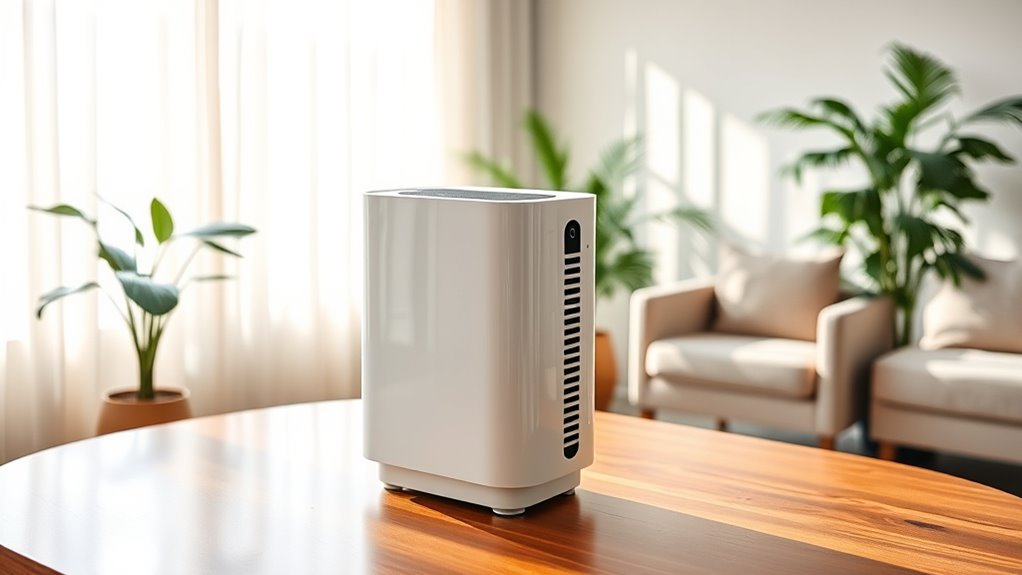
To guarantee your air purifier benefits your health without causing unintended harm, experts recommend following responsible usage guidelines. Proper use minimizes risks from indoor pollution and maximizes allergen reduction, keeping your home healthier. Make certain your purifier is suitable for your space and change filters regularly to maintain efficiency. Avoid running it continuously at high settings, which can cause unnecessary noise and energy waste. Keep your device away from sources of indoor pollution, like smoking or VOC-emitting products. Always follow manufacturer instructions for safe operation. These steps help you create a safer environment, reducing allergens and indoor pollution without risking exposure to harmful particles or mold buildup. Your careful approach ensures cleaner, healthier air that supports your well-being every day.
Frequently Asked Questions
Can Air Purifiers Remove All Types of Airborne Viruses?
Air purifiers with HEPA filters greatly improve air quality by capturing most airborne viruses, but they can’t remove all types of viruses completely. While they excel at virus removal, some tiny particles or viruses bypass filters. For full protection, combine air purifiers with good ventilation and hygiene practices. Remember, no device offers 100% virus removal, so stay cautious and maintain thorough health measures.
Do Ionizing Air Purifiers Produce Ozone That Could Harm Health?
Did you know that ionizing air purifiers can produce ozone, which accounts for about 80% of indoor ozone levels? Ozone emission from these devices can pose health risks, especially for those with respiratory issues. While they effectively reduce airborne particles, the potential for ozone to irritate your lungs makes it important to weigh models with low or no ozone emission, ensuring cleaner air without risking your health.
Are There Specific Certifications to Look for When Buying an Air Purifier?
When buying an air purifier, you should look for certification standards and quality labels to guarantee safety and effectiveness. These certifications, like CARB or Energy Star, verify the device meets strict health and environmental guidelines. Quality labels indicate the product’s reliability and performance. By choosing an air purifier with reputable certifications and labels, you can trust it won’t harm your health and will effectively improve your indoor air quality.
How Often Should Filters Be Replaced to Ensure Safety?
Did you know that regular filter maintenance can improve air quality by up to 99%? To guarantee safety, you should follow the manufacturer’s recommended replacement schedule, typically every 3 to 6 months. Keeping your filters fresh prevents buildup of dust, allergens, and bacteria. Adhering to this schedule ensures your air purifier functions effectively and keeps your indoor air safe and healthy.
Can Air Purifiers Help Reduce Indoor Allergy Symptoms Effectively?
Air purifiers can considerably improve indoor air quality and provide allergy relief by removing allergens like pollen, pet dander, and dust mites. When you choose the right purifier with a HEPA filter and maintain it properly, you’ll notice fewer allergy symptoms. Regular filter replacements ensure peak performance, helping you breathe easier. Overall, air purifiers are effective tools to enhance your indoor environment and reduce allergy-related discomfort.
Conclusion
Just like a well-tended garden can flourish or wither, your air purifier’s impact depends on proper use. I once met someone who ignored filter changes, only to find their symptoms worsened—highlighting how neglect can turn a helper into a hazard. By understanding the risks and maintaining your device, you guarantee it works for you, not against you. When used responsibly, your air purifier becomes a guardian of your health, not a source of harm.
